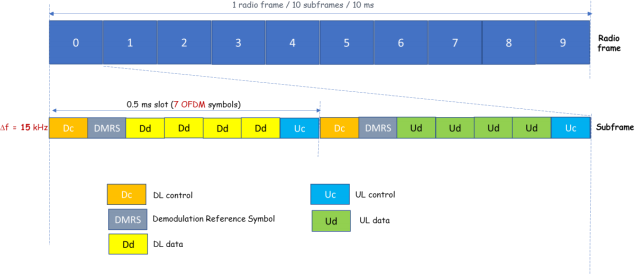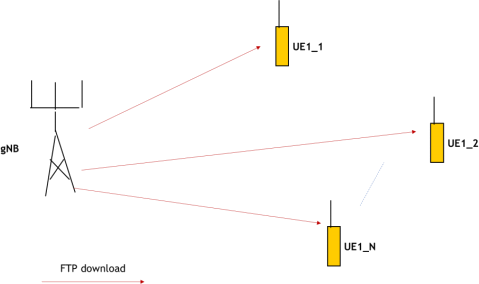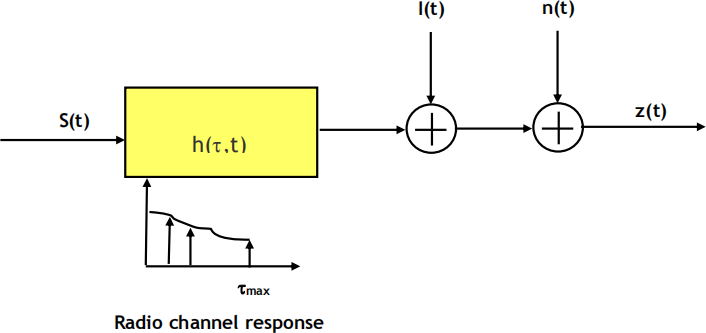ELEN E6771 Homework #2
Hello, dear friend, you can consult us at any time if you have any questions, add WeChat: daixieit
ELEN E6771 Homework #2
Due date: Friday 1pm EST, March 10, 2023.
How: Please do your best and submit your solutions in time according to class TA’s instructions. Use appropriate editors (MS word, pdf …) to present your work (no hand writing please).
Part 1: Fundamentals of 5G Design
Note: All elements of this homework/midterm were introduced by the class instructor in a self-contained manner in the first part of the course. Numerical exercises will help students understand some 5G design principles and gear up for the second part of this course.
Exercise 1
Assume the following 5G New Radio (NR) communication system, as in Figure 1, where a set of N mobiles {UE1_1, UE1_2, … ,UE1_N} are connected to a network via the transmission and reception point gNB_1 and another set of N mobiles {UE2_1, UE2_2, … ,UE2_N} are connected to the same network via the transmission and reception point gNB_2.
The system supports conversational voice with the pairing such as UE1_k is talking to UE2_k, where k is pair index and is represented by any integer value between 1 and N (N >=1).

Figure 1: Assumed voice communication system (DL and UL directions are with respect to the UE1_k mobiles)
Assume that a voice traffic source generates a voice packet of 296 bits size every 20 ms during full activity (typically known as talkspurt) and that the 5G NR radio operates with an OFDM sub-carrier separation of ![]() f = 15 kHz, with normal cyclic prefix and 7 symbols per slot, as illustrated in Figure 2. Hence, for each 15 kHz OFDM sub-carrier, in each 1ms sub-frame there are 4 symbols dedicated for the downlink (DL) data transmission (gNB to UEs) and 4 symbols dedicated for the uplink (UL) data transmission (UEs to gNB).
f = 15 kHz, with normal cyclic prefix and 7 symbols per slot, as illustrated in Figure 2. Hence, for each 15 kHz OFDM sub-carrier, in each 1ms sub-frame there are 4 symbols dedicated for the downlink (DL) data transmission (gNB to UEs) and 4 symbols dedicated for the uplink (UL) data transmission (UEs to gNB).

Figure 2: Assumed 5G NR sub-frame and slot structure (single OFDM sub-carrier representation)
Assume the following modulation schemes, as represented in Table 1. For the purpose of this exercise, transmitted bits are assumed uncoded.
|
Acronym |
Modulation |
Uncoded (bits/s) |
|
M1 |
QPSK |
2 |
|
M2 |
16QAM |
4 |
|
M3 |
64QAM |
6 |
|
M4 |
256QAM |
8 |
Table 1: Assumed modulation types
Questions:
Q1) Assume that the only active conversational pair is (UE1_1, UE2_1) and it operates at full activity for a significant talkspurt duration, e.g. 3 seconds. Assume that only a single OFDM sub-carrier is available (note: this is an hypothetical case, theoretically feasible, practically not achieved through standardization choices, as emphasized in the lectures).
For each modulation {M1, M2, M3, M4} in Table 1, compute the number of sub- frames required to transmit a single voice packet.
Hint: focus on the gNB_1 and assume that the gNB_1 to UE1_1 corresponds to the downlink transmission (for the conversation of UE2_1 with UE1_1), while the UE1_1 to gNB_1 corresponds to the uplink transmission (of the same conversation).
Q2) With the assumptions from Q1, which modulation scheme(s) allow to transmit the voice packets (on a single OFDM sub-carrier) as they get generated throughout the entire talkspurt (e.g., 3 seconds) without creating any queued voice packets.
Q3) Assume that there is an entire Physical Resource Block (PRB) of 12 OFDM sub- carriers available for supporting conversational voice, as illustrated in Figure 3.

Figure 3: Assumed 5G NR sub-frame and slot structure (PRB representation)
Assume that the only active pair is (UE1_1, UE2_1) and it operates at full activity for a significant talkspurt duration, e.g. 3 seconds.
For each modulation {M1, M2, M3, M4} in Table 1, compute the number of sub- frames required to transmit a single voice packet.
Q4) Assume that there is an entire Physical Resource Block (PRB) of 12 OFDM sub- carriers available for supporting conversational voice, as illustrated in Figure 3. Assume that there are several active pairs (UE1_k, UE2_k) operating at full activity for a significant talkspurt duration, e.g. 3 seconds.
For each modulation {M1, M2, M3, M4} in Table 1, compute how many parallel conversations (voice conversational pairs) may be multiplexed on the same PRB without creating any queued voice packets.
Exercise 2
Assume now that the 5G NR is only used for File Transfer Protocol (FTP) downloads (as in Figure 4) and that a single PRB is available for transmission, as in Figure 3. For each modulation {M1, M2, M3, M4} in Table 1, compute how many subframes are required to download a single FTP packet of size 1460 Bytes to UE1_1 (all other UEs are assumed not to be active).

Figure 4: Assumed data communication system
Part 2: OFDMA Fundamantals 2
This is an extension of the “OFDMA Fundamentals 1”problem statement (for which the complete mathematical framework/solution was provided by the instructor). Students will have the opportunity to further their fundamental knowledge by investigating the following cases:
1) Channel transmission: Case 2 – In the presence of co-channels interferers (no timing and synchronization errors)
Case 1, which was analyzed in “OFDMA Fundamentals 1 ”considered the simplified case where there are no interferers on the radio channel. Students are encouraged to review the mathematical framework provided as reference by the class instructor. While doing that, please keep in mind that there may be multiple solutions to solve this problem. Those students who see alternative ways to solve the Case 1 are encouraged to document their Case 1 knowledge accordingly!
The framework used in “OFDMA Fundamentals 1”is the baseline for analyzing the study cases of the “OFDMA Fundamentals 2”.
For Case 2, desired signal, radio channel and noise are subject to the same assumption as in “OFDMA Fundamentals 1”. The only difference with respect to “OFDMA Fundamentals 1” is the presence of interferers in the channel (I(t)) in additional to the AWGN noise.

Figure 5: Graphic representation of the signal transmission over noisy radio channels.

The range of integration in this convolutional integral (* denotes convolution) has been limited to [0, Tmax] because the channel impulse response is zero elsewhere. The following assumptions are being made:
- the channel is considered quasi-static during the transmission of the m- th symbol, implying:

- the maximum excess delay, Tmax, is smaller than the cyclic prefix

Exercise 1: Find the expression of the output demodulated signal represented by the m-th symbol on the k-th OFDM subcarrier, noted by zk,m .
Exercise 2: Find the CINRk,m, which is the subcarrier to noise and interference ratio for the k-th OFDM subcarrier during the m-th symbol.
Hint: Assume a limited number of interferes, N. Assuming that the j-th interferer transmits its m-th symbol on the k-th OFDM subcarrier the complex symbol denoted as d(j)k ,m . The resulting m-th OFDM symbol for the j-th interferer is represented mathematically as following:

This signal from the j-th interferer propagates through its own radio channel g ( j)(t, t) . Note that for interferers, each channel will have its own amplitude and phase. However, since the transmissions occur on the same type of environment, the delay profile is the same for desired signal and interferers, and all channels experience the same delay spread.
The generic channel impulse response for the j-th interferer is represented as:

where b( j)i , 9i ( j) and ti represent the amplitude, phase and delay, respectively, for the i-th path of the j-th interferer.
2023-03-11